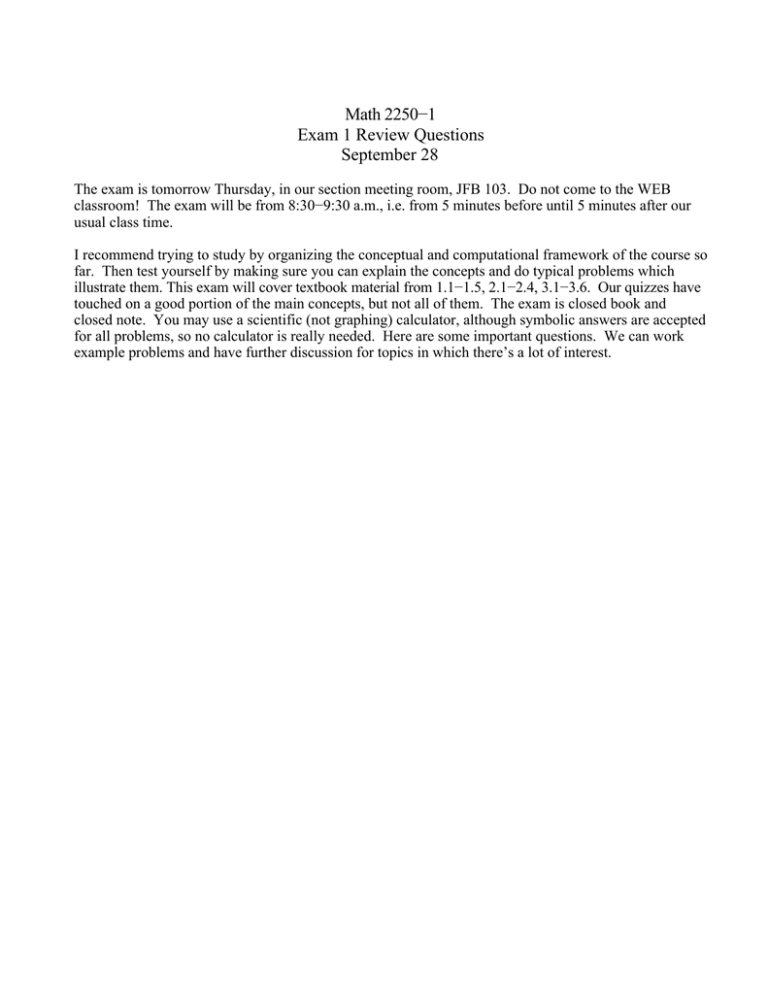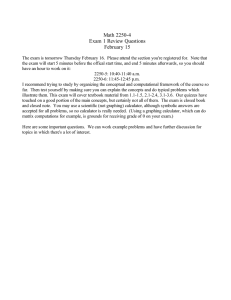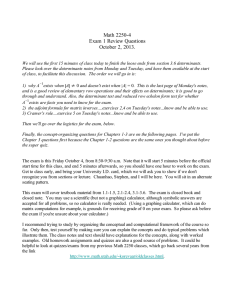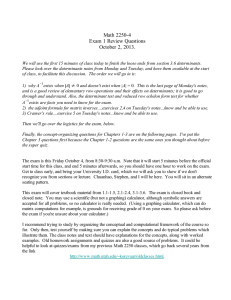Math 2250−1 Exam 1 Review Questions September 28
advertisement

Math 2250−1 Exam 1 Review Questions September 28 The exam is tomorrow Thursday, in our section meeting room, JFB 103. Do not come to the WEB classroom! The exam will be from 8:30−9:30 a.m., i.e. from 5 minutes before until 5 minutes after our usual class time. I recommend trying to study by organizing the conceptual and computational framework of the course so far. Then test yourself by making sure you can explain the concepts and do typical problems which illustrate them. This exam will cover textbook material from 1.1−1.5, 2.1−2.4, 3.1−3.6. Our quizzes have touched on a good portion of the main concepts, but not all of them. The exam is closed book and closed note. You may use a scientific (not graphing) calculator, although symbolic answers are accepted for all problems, so no calculator is really needed. Here are some important questions. We can work example problems and have further discussion for topics in which there’s a lot of interest. 1a) What is a differential equation? What is its order? What is an initial value problem, for a first or second order DE? 1b) How do you check whether a function solves a differential equation? An initial value problem? 1c) What is the connection between a first order differential equation and a slope field for that differential equation? The connection between an IVP and the slope field? 1d) Do you expect solutions to IVP’s to exist, at least for values of the input variable close to its initial value? Why? Do you expect uniqueness? What can cause solutions to not exist beyond a certain input variable value? How does Euler’s numerical method for approximating solutions to first order IVP’s relate to slope fields? 1e) What’s an autonomous differential equation? What’s an equilibrium solution to an autonomous differential equation? What is a phase portrait for an autonomous first order DE, and how do you construct one? How does a phase diagram help you understand stability questions for equilibria? What does the phase diagram for an autonomous first order DE have to do with the slope field? 2) Can you recognize the first order differential equations for which we’ve studied solution algorithms, even if the DE is not automatically given to you pre−set up for that algorithm? Do you know the algorithms for solving these particular first order DE’s? 3) Can you convert a description of a dynamical system in terms of rates of change, or a geometric configuration in terms of slopes, into a differential equation? What are the models we’ve studied carefully in Chapters 1−2? What sorts of DE’s and IVP’s arise? Can you solve these basic application DE’s, once you’ve set up the model as a differential equation and/or IVP? 4a) Can you recognize an algebraic linear system of equations? 4b) Can you interpret the solution set geometrically when there are 2 or three unknowns? 4c) Can you use Gaussian elimination to compute reduced row echelon form for matrices? Can you apply this algorithm to augmented matrices to solve linear systems ? What does the shape of the reduced row echelon form of a matrix A tell you about the solution set to Ax = b ? 4d) What properties do (and do not) hold for the matrix algebra of addition, scalar multiplication, and matrix multiplication? 4e) What is the matrix inverse, A 1 for a square matrix A ? Does every square matrix have an inverse? How can you tell whether or not a matrix has an inverse, using reduced row echelon form? What’s the row operations way of finding A 1 , when it exists? Can you use Matrix algebra to solve matrix equations for unknown vectors x or matrices X , possibly using matrix inverses and other algebra manipulations? 4f) Can you compute A for a square matrix A using cofactors, row operations, or some combination of those algorithms? What does the value of A have to do with whether A 1 exists? What’s the magic formula for the inverse of a matrix? Can you work with this formula in the two by two or three by three cases? What’s Cramer’s rule? Can you use it?




